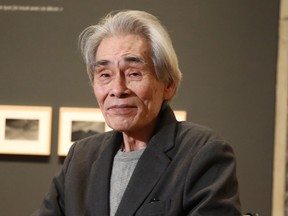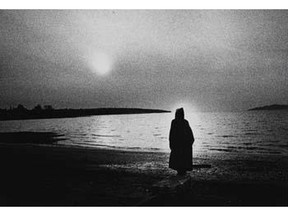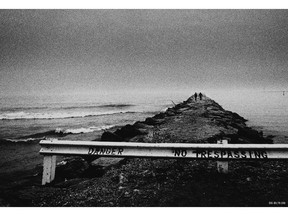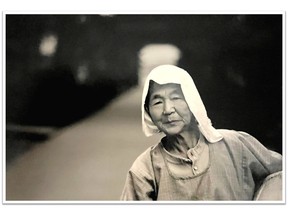
“These photographs were taken a long time ago, yet the memory of them is still fresh. I don’t feel that time has long passed.”

Reviews and recommendations are unbiased and products are independently selected. Postmedia may earn an affiliate commission from purchases made through links on this page.
Article content
Kan Azuma’s decision to move from Tokyo to Vancouver was more impulsive than carefully formulated.
It was 1970, and the then-24-year-old Japanese photographer’s Plan A was to relocate to California. Two weeks before Azuma’s flight, though, the United States embassy in Tokyo denied his visa application because he had taken part in anti-Vietnam War protests in Japan.
Advertisement 2
Article content
Article content
What was he to do, except come up with Plan B?
“I already had a ticket to North America, and the travel agency changed the destination from California to Vancouver,” Azuma told a crowd this week at the National Gallery of Canada through an interpreter.
“I decided to just go with the flow,” Azuma said. He initially was granted a tourist’s visa to stay in Canada for three months, but he wound up living and working here for a decade.
Fast forward to 2024, when photographs that Azuma, now 78, shot when he lived in Canada are included in an expansive solo exhibition at the National Gallery. Entitled Kan Azuma: A Matter of Place, the exhibit consists of more than 160 often sombre and striking black and white photographs of Canadian landscapes, people and more.
“They’re extremely poetic, they’re extremely beautiful … They wrap you into this world,” said Jean-François Bélisle, the gallery’s director and CEO. He addressed Azuma this week in person as the photographer and his wife had flown the 10,000-plus kilometres from Tokyo to Ottawa for the exhibition’s opening.
“These photos are some kind of conversation between people and place,” said Kenji Yamanouchi, Japan’s ambassador to Canada. Putting a hand to his chest, Yamanouchi said Azuma had an “enormous power to penetrate to your emotion.”
Article content
Advertisement 3
Article content
Azuma said the photographs in the exhibition reminded him of “a joyful and wonderful time in my life.
“These photographs were taken a long time ago, yet the memory of them is still fresh,” he added. “I don’t feel that time has long passed.”
Trained as a photographer at the Tokyo Design Institute, Azuma embraced a photographic style known in Japanese as are-bure-boke, which embraced the production of grainy, blurry and out-of-focus images to convey immediacy.
When Azuma touched down in Vancouver, he did not immediately work in photography, said Euijung McGillis, assistant curator of the gallery’s photographs collection. She, along with Andrea Kunard, the collection’s senior curator, are responsible for the exhibition.
In part because of his limited English, Azuma initially worked as a house painter and did odd jobs, McGillis said. Eventually he became a darkroom technician at Abbott & Tincombe Photographic Services, a Vancouver business that still exists. He later moved to Toronto, where he worked in the darkrooms at York University and even taught an introductory photography course there.
Advertisement 4
Article content
“He didn’t enjoy that very much,” said McGillis, who interviewed Azuma in 2022, by email, as part of her work.
“For me, photography was inevitable,” Azuma said in Ottawa.
He told McGillis in their email exchange: “If you ask me why I took photographs, I can only say that it was solely for personal reasons because I enjoyed the process. I have freedom and fun while working on my photographs, without being dictated to by anyone.
“Back then, nobody knew that this artistic process was good for your mental health, reducing stress,” he said. “For me, photography was a world in which it was OK not to be successful. I was sure that my creative sensibilities would wither and dissipate in 10 years, so I thought that I should take as many photos as possible and that other people would assess them.”
While Azuma lived in Canada, he sometimes traveled with photographic endeavours in mind. In 1973, he took photos at Point Pélee National Park in southwestern Ontario that came together as his Erosion series.
“I had never experienced nature this strongly before,” Azuma told McGillis.
In 1975, Azuma traveled to Peggy’s Cove, N.S., drawn by its rocky, timeless landscape. What he saw there rubbed off on him and led him to create his Other Land series, which pondered the effect of time on massive rocks, which would turn eventually to sand.
Advertisement 5
Article content
Azuma took photos of people, too. His 1975 Dodge Away series consisted of whimsical, curious portraits of people in Toronto who Azuma told to pose as if they did not want to be photographed.
“He told me that he just had so much fun taking photographs (in Canada),” McGillis said.
Years later, after returning to Japan, Azuma took photos of people who, like him, were on a special pilgrimage. Some of those images are part of the 88 Shrines Pilgrimage series, shot in 1995, and they are part of the gallery’s exhibition.
Azuma returned to Japan in 1980. His mother’s ill health was a factor. She subsequently died. For the pilgrimage that Azuma took, the promise to pilgrims who visited all 88 shrines was that they would be visited by deceased family members. Azuma “thought after finishing his pilgrimage he might be able to see his mother’s face,” McGillis said.
While Azuma lived in Canada, his work was exhibited several times, including a 1974 exhibition at a Kent Street gallery in Ottawa. Around that time, the National Gallery acquired about 70 of Azuma’s works for its collection.
Advertisement 6
Article content
After Azuma returned to Japan, he worked as a photographer, sometimes shooting photos at concerts for music magazines. He retired after he turned 55.
“Regardless of whether my experience in Canada was a success or not, it was the beginning of a fulfilling creative pursuit,” Azuma told McGillis. “When I look back on my subsequent works, they showed my honest self instead of trying to please people.”
Just a few years ago, the National Gallery’s interest in Azuma’s photos swelled after a Japanese intern’s curiosity was piqued. Staff at the gallery tried to find Azuma and ultimately contacted him via Facebook, McGillis said.
Now, not only are Azuma’s work being shown until mid-June at the gallery, but he has also donated more than 300 prints, contact sheets, negatives and notes to the National Gallery of Canada Library and Archives.
Azuma’s solo exhibition, McGillis said, is “what he deserves, and didn’t happen when he was here.
“We didn’t get a chance to hear his voice when he was active in Canada,” she said. “We’re just a bit late, but we’re not too late.”
Kan Azuma: A Matter of Place
What: a solo exhibition of a Japanese photographer who lived in Canada in the 1970s
Where and when: National Gallery of Canada until June 16
Also: some Kan Azuma photos will remain on display in Clarendon Court in the ByWard Market until March 31, 2025
Did you know we have a weekly newsletter all about food, events and cool things happening in Ottawa? Sign up for Ottawa, Out of Office — our weekly guide gives readers the inside scoop on the best of Ottawa.





Recommended from Editorial
Article content

